
Herbaceous plants in botany, frequently shortened to herbs, are vascular plants that have no persistent woody stems above ground. Herb has other meanings in cooking, medicine, and other fields. Herbaceous plants are those plants that do not have woody stems, they include many perennials, and nearly all annuals and biennials, they include both forbs and graminoids.
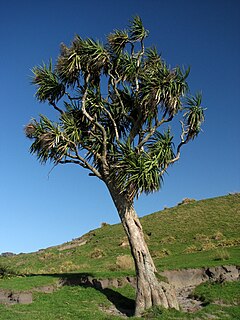
Cordyline australis, commonly known as the cabbage tree, or cabbage-palm, is a widely branched monocot tree endemic to New Zealand.

Leucanthemum vulgare, commonly known as the ox-eye daisy, oxeye daisy, dog daisy and other common names, is a widespread flowering plant native to Europe and the temperate regions of Asia, and an introduced plant to North America, Australia and New Zealand.

Holcus lanatus is a perennial grass. The specific epithet lanatus is Latin for 'woolly' which describes the plant's hairy texture. Common names include Yorkshire fog, tufted grass, and meadow soft grass. In North America, where it is an invasive species, names include velvet grass and common velvet grass.

Alchemilla alpina, commonly known as alpine lady's-mantle, is an arctic-montane herbaceous perennial plant native to Europe and Southern Greenland.

Fuchsia magellanica, commonly known as the hummingbird fuchsia or hardy fuchsia, is a species of flowering plant in the family Evening Primrose family, native to the lower Southern Cone of southern South America.
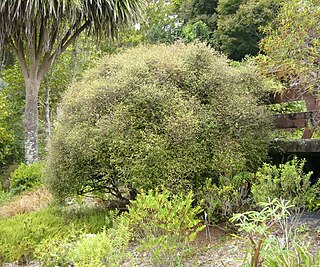
Muehlenbeckia astonii or shrubby tororaro is an endemic New Zealand shrub in the family Polygonaceae. It has distinctive small heart-shaped deciduous leaves amidst a tangle of wiry interlocking branches. Although common in cultivation around the world, it is extremely rare and threatened in the wild.
The Kerguelen Islands are part of the Southern Indian Ocean Islands tundra ecoregion that includes several subantarctic islands. In this cold climate plant life is mainly limited to grasses, mosses and lichens, although the islands are also known for the indigenous edible Kerguelen cabbage. The islands are at the Antarctic convergence, where cold water moving up from the Antarctic mixes with the warmer water of the Indian Ocean. As a consequence, marine mammals, especially seals, and seabirds and penguins are numerous.
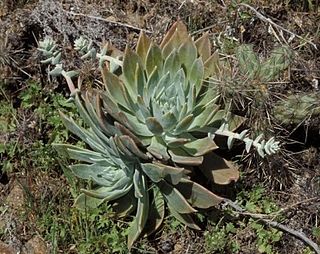
Dudleya traskiae is a rare succulent plant known by the common name Santa Barbara Island liveforever. This Dudleya is endemic to Santa Barbara Island, one of the Channel Islands of California, where it grows on rocky bluffs. The plant has a basal rosette of flat, spade-shaped fleshy leaves up to 15 centimeters long, which are pale green to yellowish. It erects tall stems bearing dense, rounded inflorescences of many bright yellow flowers.
This is a list of the flora of South Georgia, an island in the subantarctic Atlantic Ocean, part of the British overseas territory of South Georgia and the South Sandwich Islands.

Galeopsis bifida is an annual plant native to Europe and Asia but now found in Canada and the northeastern, midwestern parts of the United States. It has many common names such as bifid hemp-nettle, split-lip hemp-nettle, common hemp-nettle, and large-flowered hemp-nettle. The genus name means weasel-like, referring to the corolla of the flower. It is often confused with other species of Lamiaceae such as Mentha arvensis, Dracocephalum parviflorum and Stachys pilosa.

Gahnia grandis is a tussock-forming perennial plant found in southeastern mainland Australia and Tasmania.

Agrostis magellanica is a species of grass. It has a circumpolar distribution and is native to many subantarctic islands in, and the coasts bordering, the Southern Ocean.
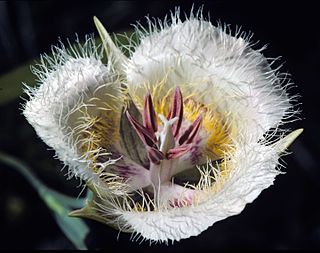
Calochortus coxii is a rare species of flowering plant in the lily family known by the common names Cox's mariposa lily and crinite mariposa lily. It is endemic to Oregon in the United States, where it is known only from Douglas County.

Austroderia richardii, syn. Cortaderia richardii, is a species of flowering plant in the family Poaceae. It is an evergreen perennial grass. The genus Austroderia is often called "pampas grass", though this name usually refers to A. selloana. "Early pampas-grass" is a more specific name. The name "tussock grass" may also be found. The Maori name is "toetoe". It is one of five species in the genus Austroderia that are endemic to New Zealand. It occurs in the South Island and possibly also in the North Island. It is also an introduced species in Tasmania, Australia.
Acaena minor is a species of flowering plant whose range is confined to Australia's subantarctic Macquarie Island and to New Zealand's Campbell and Auckland Islands in the Southern Ocean.

Melampyrum arvense, commonly known as field cow-wheat, is an herbaceous flowering plant of the genus Melampyrum in the family Orobanchaceae. It is striking because of the conspicuous spike of pink or purple terminal bracts which includes the flowers.
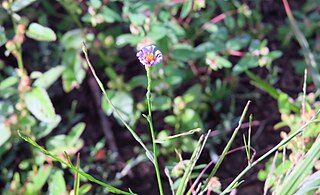
Symphyotrichum subulatum is an annual plant in the sunflower family Asteraceae, native to the eastern US and the Gulf coast to Texas.

Lolium rigidum is a species of annual grass. Common names by which it is known include annual ryegrass, a name also given to Italian ryegrass, rigid ryegrass, stiff darnel, Swiss ryegrass and Wimmera ryegrass. It is a native of southern Europe, northern Africa, the Middle East and the Indian subcontinent and is grown as a forage crop, particularly in Australia.

















